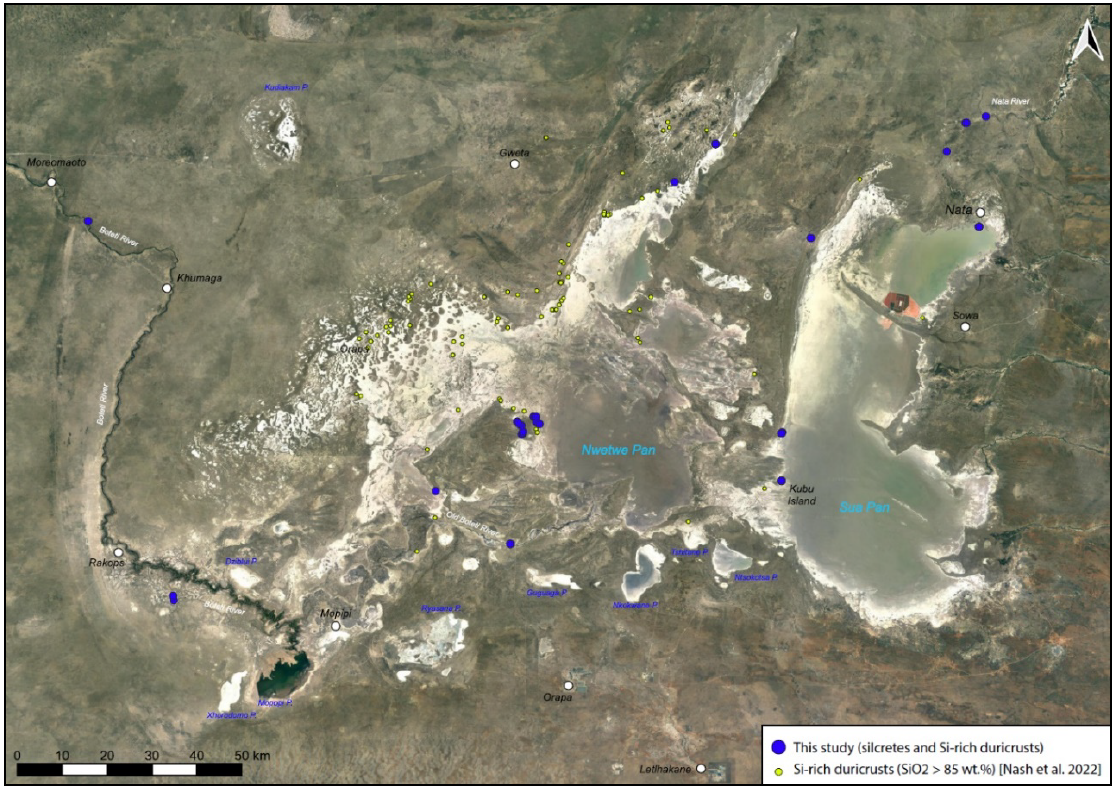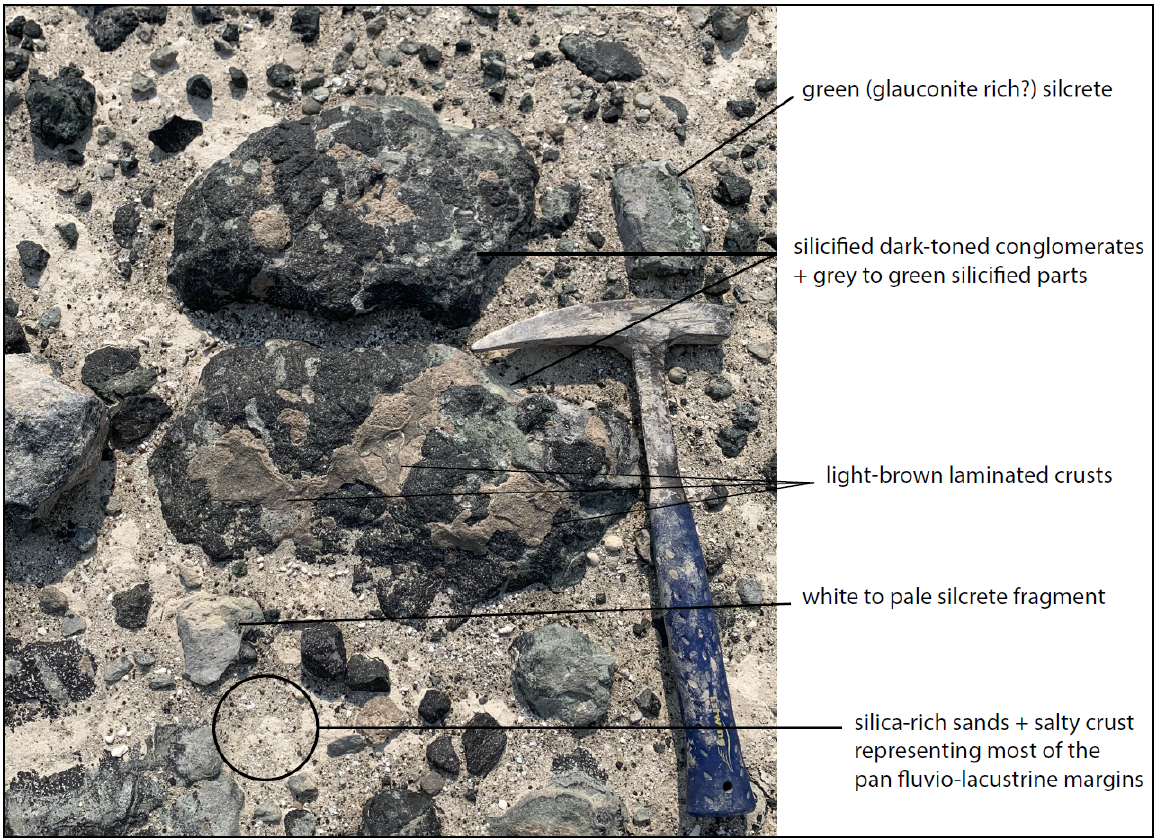The Makgadikgadi Pans as an Analogue to Ancient Silica-Rich Aqueous Environments on Mars: A Preliminary Assessment
- 1Laboratoire d'Astrophysique de Marseille, Aix-Marseille Université, Marseille, France (maxime.pineau@lam.fr)
- 2Laboratoire de Planétologie et Géosciences, Nantes Université, Nantes, France
- 3Physique des Interactions Ioniques et Moléculaires, Aix-Marseille Université, Marseille, France
- 4Institut d'Astrophysique Spatiale, Université Paris-Saclay, Orsay, France
Introduction: Hydrated silica (SiO2,nH2O) occurs in various forms depending on the geological context, and as such are good tracers for paleoenvironmental reconstitutions on Earth and Mars (e.g. [1,2]). Their potential to sequester and preserver organic matter further makes them prime exobiological targets [3]. Observed on Mars since over a decade [4], hydrated (opaline) silica minerals have been used to describe aqueous geological processes in diverse regions. However, geological origins of some deposits are still misunderstood because no satisfactory terrestrial analogues were found (e.g. [5]). Likewise, the exobiological potential of hydrated silica as a prime host of Mars organic matter remains to be fully ascertained. The Makgadikgadi Salt Pans show a very high potential to be considered as a terrestrial analogue site for Mars ancient aqueous environments, especially in fluvio-lacustrine geological settings [6,7]. A field trip was conducted in 2023 to study more specifically the silica-rich environments which were reported in the area [8-10].
Samples and method: 15 locations in the Makgadikgadi Pans area (Nwetwe and Sua Pans), along the Nata, Old Boteti and Boteti rivers were visited (Fig.1). We sampled ≈80 silica-rich rocks (i.e., silcretes) in a (paleo) fluvio-lacustrine geological context. Some visible-near infrared spectra of the surface of the samples were acquired using an ASD FieldSpec portable spectrometer (0.35-2.5µm) to evaluate the mineralogy of the rocks. A detailed analysis of the mineralogy of the samples was conducted in the lab, so far including: optical microscopic observation on raw samples and extracted thin sections, VNIR hyperspectral imaging (402-2504 nm), Raman, electron microscopy and geochemical analysis (EDS).
Results in the field: In-field analysis using the portable field VNIR spectrometer suggested the ubiquitous presence of hydrated silica and phyllosilicate minerals. Based on spectroscopic and macroscopic observations in the field, most of the samples are silicified/indurated clastic sedimentary rocks and consist of coarse-grained quartz-rich sandstones and conglomerates with a fluvio- lacustrine origin (Fig. 2). Clasts in the sedimentary rocks can be of various types, fragments of quartz pebbles or sometimes opaline silica to detrital fragments of other silica-rich clastic sedimentary rocks. Matrix between the clasts is of different nature from one sample to another; it can be either opaline or microcrystalline silica and sometimes consists of clay-rich cemented materials. Depending on the nature of the clasts and matrix, the samples exhibit different colours: from white to creamy-white shades, from dark-toned shades of green, brown, and black. Samples consisting of translucent opaline and/or microcrystalline silica plates were also taken. Field observations and spectral analyses confirm the large amount of amorphous to (micro-) crystalline silica in the samples, along with different clays and salts. This type of mineralogy, possibly indicating a formation in a fluvio-lacustrine context in semi-arid environments, is reminiscent of some silica-rich deposits on Mars in locations interpreted as potential paleo-lakes [e.g. 2,5].
Results in the lab: VNIR and Raman analysis permit us to identify several mineral phases that are present in our samples. Microcrystalline silica is present in most of the samples along with various phyllosilicatesand sulfates in mixtures with silica or as (clayey) salty crusts. The presence of the mineral glauconite, suggested in the literature for these silcretes, giving this pale green colour, is verified in our spectra and support the fluvio-lacustrine origin in a semi-desertic environment for these silica deposits. Microscopic and EDS analysis show that hydrated silica is found in several types of contexts, ranging from inherited in the sediments to later-stage reprecipitation in voids.
Perspectives: Laboratory analyses have recently begun and a systematic comparison between samples is underway to find trends between geological setting, composition, and lithology. Of particular interest we are investigating how the whole-rock VNIR spectra relate to the fine distribution and abundances of the minerals comprising the rock. This has strong implications for better benchmarking the sensitivity level and potential detection biases of similar instrument at Mars, both in-situ (e.g. SuperCam/Mars 2020) or from orbit (OMEGA/Mars Express and CRISM/MRO imaging spectrometers). We will investigate how the carbonate/calcrete and phyllosilicate matrix may inhibit the hydrated silica signatures and vice-versa. These observations will be compared to the observations of silica-rich deposits at the surface of Mars, and possibly supported by remote sensing data from the Makgadikgadi area (e.g., EnMap data). Finally, we also aim to better understand the exobiological potential of this type of deposit by studying the sequestration of various organic compounds in these silicified rocks.
Acknowledgments: We acknowledge support from the Agence Nationale de la Recherche in France (“PaleoSilica” project) under contract ANR-20-CE46-0013. We also acknowledge support from Europplanet Society Transnational Access Funding for site TA5.1 under program 22-EPN3-127. Our warmest gratitude for the logistical and scientific support provided on site by Prof. F. Franchi of BIUST.
References: [1] Boudreau A., et al. (2012) J. Volc. & Geoth. Res., 247–248, 1-8. [2] Pineau M., et al. (2020) Icarus, 347, 113706. [3] McMahon S., et al. (2018) JGR, 123(5), 1012-1040. [4] Milliken R., et al. (2008) Geology, 36(11), 847–850. [5] Pan L., et al. (2021) Planet. Sci. J., 2, 65. [6] Franchi F., et al. (2020) PSS, 192, 105048. [7] Schmidt G., et al. (2023) Front. Astron. Space Sci., 10, 1108386. [8] Stephan K., et al. (2023) 54th LPSC, abstract #1507. [9] Nash D., et al. (2022) Quat. Sci. Rev., 297, 107811. [10] Ringrose S., et al. (2009), Sediment. Geol., 219, 262-279.

Fig.1 Satellite view of the Makgadikgadi Salt Pans with sampling locations (blue circles). The yellow circles on the map represent silica-rich rocks (silcretes and duricrusts) locations from a publication by [9].

Fig.2 Example of a silcrete boulder outcrop at the Old Boteti River Paleo-Delta on the western margin of the Nwetwe Pan. Various examples of coloured silcretes are indicated, topped in places by a light-brown laminated crust.
How to cite: Pineau, M., Gouzy, S., Vinogradoff, V., Carter, J., and Rondeau, B.: The Makgadikgadi Pans as an Analogue to Ancient Silica-Rich Aqueous Environments on Mars: A Preliminary Assessment, Europlanet Science Congress 2024, Berlin, Germany, 8–13 Sep 2024, EPSC2024-991, https://doi.org/10.5194/epsc2024-991, 2024.